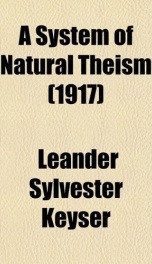a system of natural theism

Purchase of this book includes free trial access to www.million-books.com where you can read more than a million books for free. This is an OCR edition with typos. Excerpt from book: CHAPTER III TELEOLOGICAL ARGUMENT1 I. DEFINITIONS 1. Etymology of the term: Tt'Aos, end, and Aoyos, discourse. 2. The Teleological2 Argument is the proof of the divine existence which is based on the evidence of design, purpose and adaptation in the creation. It is often called the argument of design, purpose or final cause. 3. The Final Cause is the end or purpose in the mind of the designer in the planning and making of a structure. It is called the Final Cause because its manifestation appears at the end of the process. In reality it is the primary cause, for it exists first of all in the mind of the designer. 4. The Efficient Cause is the force or forces employed by the designer to bring about the desired effect. 5. Adaptation is the selection and use of the proper means to secure the desired end. 6. Final Cause and Efficient Cause are thus related: The former determines what forces or energies shall constitute the latter and how they shall be employed throughout the process. Final Cause is dependent on the Efficient Causes that are available for accomplishing its purpose. Thus they are mutually dependent. Efficient Cause without Final Cause would bring only chaos; Final Cause without Efficient Cause would be helpless. 1. On this argument compare the following valuable works: Valentine. ut supra, pp. 74-205 (most thorough-going); Orr, "The Christian View of God and the World," pp. 97-103, 415-418; Lindsay, "Recent Advances in Theistic Philosophy," pp. 170-215; Fisher, "The Grounds of Theistic and Sometimes' called the Eutaxiological Argument when design in the universe as a whole is considered. From eurua, order, and Xc$-yos. II. PROOFS OF DESIGN IN THE COSMOS8 1. In organisms: The eye, the ear, the hand, foot, lungs, heart, man's entire ...
Info about the book
Author:
Series:
Unknown
ISBN:
1103991108
Rating:
5/5 (3)Your rating:
0/5
Languge:
English
Users who have this book
Users who want this book
What readers are saying
What do you think? Write your own comment on this book!
write a commentif you like a system of natural theism try:
Other books by this author
Do you want to read a book that interests you? It’s EASY!
Create an account and send a request for reading to other users on the Webpage of the book!



